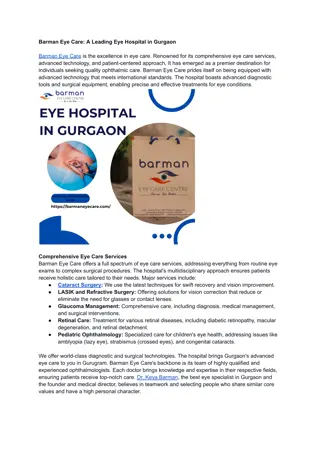Exploring the Fascinating World of Sight: Light, Optics, and Eye-Brain Connection
Delve into the intricate workings of how we perceive the world through sight. From understanding the behavior of light in optics to the vital role of the eye-brain connection, embark on a journey through visuals, optical illusions, and thought-provoking insights. Meet Eyevan and unravel the mysteries of light reflection and how our eyes interpret the world around us.
Download Presentation

Please find below an Image/Link to download the presentation.
The content on the website is provided AS IS for your information and personal use only. It may not be sold, licensed, or shared on other websites without obtaining consent from the author. Download presentation by click this link. If you encounter any issues during the download, it is possible that the publisher has removed the file from their server.
E N D
Presentation Transcript
How We See MS. KUEH MONDAY, SEPTEMBER 16, 2024
UNDERSTANDING SIGHT To understand sight, you have to understand: Light Eye-Brain combination We will focus mostly on how light behaves in the physical world. The study of this is called Optics
Spiral http://www.michaelbach.de/ot/mot_adaptSpiral/index .html
EYE & BRAIN We see things using a combination of our eyes and brain. http://www.michaelbach.de/ ot/mot_adaptSpiral/index.ht ml
Optical Illusions Upside Down Goggles http://www.ted.com/talks/beau_lotto_optical_illusi ons_show_how_we_see
SAY HELLO TO EYEVAN! Eyevan the Eye-Brain will be used throughout our lessons, so get used to seeing him!
LETS PLAY WITH LASERS! Why can t we see a laser until it hits the wall or another object?
SEE IT TO BELIEVE IT Tyndall Effect describes the reflection of light by very small particles in suspension in a transparent (See-through) medium
ANOTHER WAY TO THINK OF LIGHT Light leaving the candle travels in all directions, but we only SEE the light that travels in to our Eye-Brain
ANOTHER WAY TO THINK OF LIGHT (CONT D) We don t see light that doesn t enter our eyes.
ANOTHER WAY TO THINK OF LIGHT (CONT D) If the light going away from eyes is reflected in to our Eye-Brain, then we will see it.
SIDE NOTE When we look at diagrams, we will ignore light that doesn t enter our Eye-Brain. Don t forget that the other light exists, we are just ignoring it to simplify our lives!
RAYS & DIAGRAMS Ray Diagrams show how light moves from the object to the eye. Light Ray a line on a diagram representing the direction and path that light is travelling.
RAYS & DIAGRAMS Light is a type of energy our eyes are sensitive to. Considered an Operational Definition because it only describes HOW we detect light, but doesn t tell us WHAT light is.
RAYS & DIAGRAMS Rectilinear Propogation describes how light always travels in straight lines. Think of shadows and what they look like. They perfectly copy whatever the object is.
CAN HE SEE EYEVANS FEET? Based on what you know so far about light rays and how you see, would you be able to see Eyevan s feet?
CAN YOU SEE EYEVANS FEET? Light travels in straight lines from Eyevan s feet, but not directly in to your eyes. (Rectilinear Propagation)
Additive Colour Theory of Light white light is composed of different colours (wavelengths) of light white light can be produced combining only three colours One such combination is red, green and blue
Additive Colour Theory of Light Primary Colours for Light Red, Green, Blue If you mix only two primary colours together you make a secondary colour.
When Light Hits an Object It can be absorbed It can bounce off the object (reflect) It can change direction (refraction in transparent objects)
Subtractive Colour Theory of Light The colour you see when you look at an object depends on the wavelengths that are reflected
How do we get the colour black? A black object absorbs all colours while a white object reflects all colours. A blue object reflects blue and absorbs all other colours.
Subtractive Colour Theory of Light The primary and secondary colours of light for the subtractive theory are opposite to the colours of the additive theory.
Subtractive Colour Theory of Light Cyan, magenta and yellow are the primary subtractive colours while red, green and blue are the secondary subtractive colours.
LUMINOUS SOURCES Atoms in LUMINOUS OBJECTS emit light rays in all directions produced from other energy sources. Atoms in NON-LUMINOUS OBJECTS scatter the light rays from luminous objects in all directions.
NOTE Atoms in all objects produce or scatter light rays. This diagram only shows light rays from atoms at the top and bottom of the objects.
KEEP IT SIMPLE To make diagrams simpler, we only show one ray of light from the top and bottom of objects. We simplify it even more and just show only the rays coming from the top of the object.
MEDIUMS A TRANSPARENT MEDIUM allows nearly all rays to pass straight through unaltered. (Ex. Air) An OPAQUE MEDIUM absorbs or scatters all the rays. (Ex. Textbook, wall, etc.)
MEDIUMS (CONTD) A TRANSLUCENT MEDIUM transmits and scatters the rays. The medium indicates whether it is being illuminated by the object can not be clearly seen. (Ex. Wax Paper)
Depth Perception Depth Perception - Two eyes in front of a head can determine the object s location better because the rays entering each eye can be used by brain to triangulate where the object is.
Depth Perception Pencil Touch Activity!
The Floating Finger 1)Hold your left and right forefingers about 30 cm in front of your eyes. Hold them horizontally about 2-3 cm apart. 2)Focus your eyes at a far point. Do not focus on your fingers.
The Floating Finger Did you see a piece of finger floating in the air?
The Floating Finger The eyes are focused on a point located far away. The Eye-Brain uses two slightly different sets of rays to triangulate the distance. But we still see objects that are closer to the eyes.
Right Eye Image Left Eye Image Both Eye Images Combined
EXAMPLE OF CONFUSION Animals with eyes on the side of their head (like horses) can only see the object with one eye at a time. They can not use the triangulation method to determine the object s location.
Horses Eye-sight These animals must use the object s apparent size to determine its location. Their depth perception will be poor.
HOMEWORK Read section 11.4 Homework: pg. 481 #1, 3, 5 (draw a diagram)























